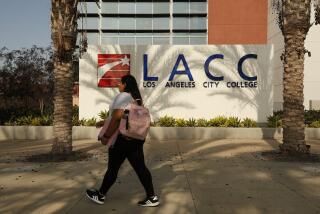Let’s bring back the idea of a free UC education
The son of a railroad worker, Earl Warren came from a family keeping a desperate finger hold on a working-class existence at the turn of the last century. Yet when he left high school in Bakersfield in 1908, there was no question where he was headed: to Berkeley and a free education at the University of California.
There he proved an indifferent student scholastically but an enthusiastic absorber of “the new life, the freedom, the companionship, the romance of the university,” Warren recalled years later. “It was like being in wonderland.”
No one could deny that one way or another, the education took: The graduate of UC Berkeley and Boalt Hall served as California attorney general, won three elections for governor, and during his nearly 16 years as chief justice of the United States led a Supreme Court that produced (among other decisions) that landmark of landmarks, Brown vs. Board of Education.
The writer Maxine Hong Kingston was born to Chinese immigrants who had settled in Stockton with their devotion to education intact. When college beckoned in 1958 the cost of attending UC Berkeley was $75 a semester, which for her was covered by a scholarship.
Another option might have been Stanford, “but there was no way anybody could afford that,” she told me. Kingston published her first book, “The Woman Warrior: Memoir of a Childhood Among Ghosts,” in 1976, and turned out a body of work illuminating the immigrant experience, earning such recognitions as the National Humanities Medal. She spent 25 years teaching English at UC Berkeley — “I did not want to accept a teaching job anywhere else,” she said. “It was my alma mater.”
The roll of Californians who rose from modest circumstances to enrich our lives and our society after receiving a taxpayer-supported education at the University of California — or Cal State or the community college system — is too long to enumerate here. They’re scientists who made world-altering discoveries, literary artists, composers and musicians, political leaders of city, state and country.
But the recent trend in state support of public higher education raises a question germane to the careers of Warren and Kingston and all those others: If they graduated from high school today, would they have any chance of getting a UC education?
The principle of free tuition for state residents was deeply ingrained in UC from its founding in the 1860s and reaffirmed in the 1960 master plan for public higher education, which acknowledged the university’s role as a driver of economic growth. Raising the instructional costs for students, the master plan said, would negate “the whole concept of wide-spread educational opportunity made possible by the state university idea.”
So here’s a radical proposal: As tuition increases threaten to place a UC education out of the reach of working-class and middle-class students, let’s reinvigorate the notion of a free UC education.
The chief objection to this idea isn’t hard to predict: “We can’t afford it!” Yet it’s odd how eliminating in-state tuition is regarded today as completely out of the bounds of good sense, while proposals with far greater fiscal impact are floated routinely and given sober consideration. Eliminating all in-state tuition at UC would cost less than $3 billion a year. (That comes from the university’s report on its core operating budget for 2011-12.) During her ill-starred run for governor in 2010, Meg Whitman proposed eliminating the state tax on capital gains, which brings in about $11 billion in a good year.
The tax-cutters’ theme is that their policies stimulate the economy. But few things stimulate the economy over the long term as much as a well-educated workforce.
“If our crown jewels are lost, industry’s going to pay a huge price,” said Robert Reich, the U.S. secretary of Labor in the Clinton administration who is now a professor of public policy at UC Berkeley.
The bounty California reaped by providing an essentially free education to its most promising high school graduates largely has been forgotten, which only makes it easier for political leaders to keep cutting state budget support.
“Most of the public does not know how much has been taken away from the UC and CSU system,” Reich said. “Most people I come across are amazed to discover how little of the budget is coming from Sacramento. They assume it must be 70 or 80 or 90%.”
In fact, it’s about 11%, a level that has been falling for 20 years. The slack has been taken up by tuition charges, which have roughly tripled on a per-student basis to $13,200 this year. Combine that with soaring costs for room, board, books and supplies, and a public college education is getting priced out of reach for all but the wealthiest families and the poorest, whose costs are covered, albeit by financial aid programs that are constantly menaced by budget cuts. Since a college degree increasingly is the sine qua non for middle-class earnings, the trend threatens to aggravate America’s already troubling economic disparities.
The other shoe that’s dropped in this crisis is the shrinkage in available slots for California students as opposed to nonresidents, who pay $36,078 this year. Thanks to the nonresident tuition revenue monkey on its back, the percentage of Californians among UC Berkeley’s incoming freshmen fell below 69% last year, down from more than 86% two years earlier. At UCLA, the figure dropped more than 11 percentage points to 70.2%. That’s comparable to the nonresident levels at state universities that have long since remade themselves as quasi-private institutions, such as Michigan and Virginia.
In consequence, the higher education system’s ability to serve the state is deeply compromised.
“People tend to assume that you have a son or daughter or grandson or granddaughter at the university for you to be interested in how the university fares,” UC President Mark Yudof said. “What we’re trying to say is whether it’s the arts or reducing the crime rate or creating new companies and new product lines, if you live here in California and you want to do well, you have an interest in how UC does.”
The struggle to maintain UC’s quality without driving student costs out of reach is coming to a head. Students protested rising tuition at the regents meeting in January at UC Riverside. Yudof, meanwhile, is hoping to reach an agreement with Gov. Jerry Brown and legislative leaders to increase state funding to UC, which has fallen to $2.27 billion today from $3.25 billion in 2007-08, by $700 million to $800 million over the next five years.
Yudof says he’s receptive “conceptually” to an idea floated by Fix UC, a group originating at UC Riverside, to allow students to attend tuition-free but pay back their costs at the rate of 5% of their salaries over 20 years.
“I don’t think anyone at any UC campus doesn’t know people who are struggling with finances,” said Chris LoCascio, 20, a third-year student at UC Riverside who heads Fix UC. The virtue of the plan, the group says, is that it doesn’t saddle students with upfront educational costs or loan payments that kick in at the point where they can easily exceed their means.
The partnership implicit in such a plan would demonstrate the state’s commitment to public higher education and the taxpayers’ understanding that these institutions are not a burden but a public boon. To project their value for the future we need only to remember their past.
Glenn Seaborg (UCLA ‘33) helped win World War II by discovering plutonium, and later repaid his debt to UC by serving as chancellor at Berkeley. Ralph Bunche (UCLA ‘27) became one of our most distinguished diplomats and civil rights leaders, the first black Nobel Peace Prize laureate. Former Los Angeles Mayor Tom Bradley entered UCLA in 1937, left to join the LAPD and became one of this state’s outstanding political leaders. And that’s not to mention the thousands of alumni of UC Davis, UC San Diego, UC Santa Barbara and other campuses. Isn’t this the UC we want?
Michael Hiltzik’s column appears Sundays and Wednesdays. Reach him at mhiltzik@latimes.com, read past columns at latimes.com/hiltzik, check out facebook.com/hiltzik and follow @latimeshiltzik on Twitter.







